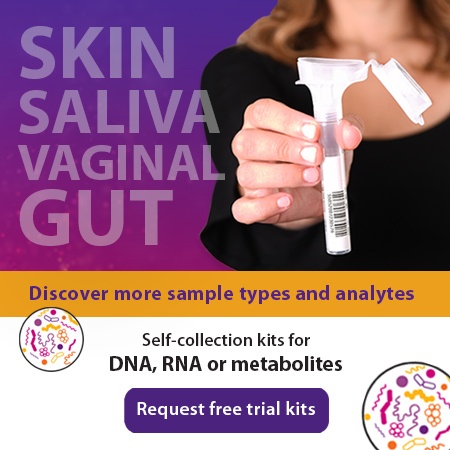2019-10-16
The “gold standard” for gut microbiome studies has traditionally been a fresh stool sample that was immediately processed or immediately frozen at -20ºC or -80ºC. However in hospital settings, this can be very difficult.[1]
“Refrigeration of samples is difficult due to limited resources, irregular sampling time-points or patients’ visits, as well as the need to prioritize patient care.” Ilett et al.
Is this ideal sample collection method really considered the “gold standard” anymore? If not, what is the alternative? In this blog we explore Ilett et al.’s comparative study on the quality of fresh stool samples versus stabilized stool samples, and Panek et al.’s publication on the methodology challenges in studying the human gut microbiota.
Past microbiome studies
Before we dive into the work of Ilett et al., let’s explore what recent studies have found regarding fresh vs stabilized stool samples. One such study, Panek et al., Methodology challenges in studying human gut microbiota – effects of collection, storage, DNA, extraction and next generation sequencing studies, showed that there is an unmet need for standardization of methodology when it comes to studying the gut microbiome. [2]
In earlier decades, analysis of the human gut microbiome was initially performed by culture dependent methods which limited the outputs of cultivable species in stool samples. Due to the rise of next generation sequencing, gut microbiome studies now rely on stool collection methods to study the bacterial content. According to Panek et al., current collection protocols propose the immediate use of fresh or rapid freezing at -80ºC or -20ºC to preserve the specific microbial community composition in faecal samples.[2]
The authors found that extracting DNA from stabilized samples collected using the OMNIgene·GUT collection kit, resulted in a higher DNA yield than conventional feces collection methods, and that OMNIgene·GUT enabled reliable faecal sample collection, transport and storage compared to freshly collected material. [2]
“Studies evaluating OMNIgene·GUT, a commercially available faeces collection/stabilization system, indicated this system was equivalent to, or superior in maintaining sample microbial composition to freezing, resulting in very few alterations to fresh stool samples.” Panek et al.
However, how does the quality of the DNA compare?
Quality battle: Fresh vs stabilized stool samples
A number of hospitals are trying to build biobanks of stool samples to be used downstream for research projects. Ilett et al. recently published Gut microbiome comparability of fresh-frozen versus stabilized-frozen samples from hospitalized patients using 16S rRNA gene and shotgun metagenomic sequencing, in Nature in September of 2019. Their goal was to determine which sample collection method was best for these biobanks. They focused their comparative study on alpha diversity, beta diversity, taxonomy and relative abundance using two different Next Generation Sequencing (NGS) technologies: 16S rRNA sequencing and shotgun metagenomic sequencing.[1]
“Complete capture and follow up of many patient populations would require at home sampling of out-patients, adding further variability to the time between sampling and freezing. Therefore, the ideal sample collection method within hospitals would rather allow for samples to be kept at room temperature prior to freezing. This would enable home sample collection for out-patients, no need for urgent hospital carriers for sample delivery and requirements for same-day DNA extraction.” Ilett et al.
Alpha diversity and beta diversity
Ilett et al. wanted to compare stabilized samples (SF) [using OMNIgene·GUT], to direct freezing of fresh samples (FF). They performed 16S rRNA sequencing and shotgun sequencing to compare data quality of alpha and beta diversity between them. They found that there was no significant difference between SF and FF samples regarding alpha diversity and beta diversity when 16S and shotgun were performed.[1]
Taxonomy and relative abundance
16S rRNA sequencing also revealed that there was no significant differences between SF and FF regarding relative abundances. With shotgun sequencing they found the relative abundances to be similar between the two, however they did find a difference in abundance of 7 genera between FF and SF.[1]
“This highlights the sensitivity and reproducibility of shotgun based sequencing, but also demonstrates the lack of consistent or predictable change one would expect if driven by sample methodology.” Ilett et al.
Who wins the quality battle?
In this fight for quality of microbial DNA there isn’t really a winner. Studies such as Ilett et al., have proved that samples stabilized (SF) using OMNIgene·GUT are comparable with freshly frozen (FF) fecal samples when it comes to quality.[1]
Why is OMNIgene·GUT the new “gold standard”?
“OMNIgene·GUT was found to have the least effect on gut microbiome composition compared to stabilisation fluids, with results generally being comparable to FF samples, and difference among sampling methods being of a lower scale then these between individuals.” Ilett et al.
Unlike freshly frozen stool samples, OMNIgene·GUT provides easy self-collection that can be collected at home, stored at room temperature for 60 days to eliminate the need to refrigerate during transportation and storage; therefore, eliminating bias introduced by microbial growth and DNA degradation via cold chain transport of freshly frozen stool samples. The DNA quality is comparable to fresh samples and using collection methods such as OMNIgene·GUT can reduce unnecessary costs on resources and reduce challenges with donor recruitment in clinical and hospital settings.
In conclusion, the microbial DNA quality of the “gold standard” is comparable to OMNIgene·GUT, however, the advantage of using OMNIgene·GUT over freshly frozen samples is the methodologies involving transport, storage and collection.
To learn more about the methodologies and challenges of collecting fresh stool samples, read Cold chain stool sample collection: A series of unfortunate events Parts 1 to 3 below.
Cold chain stool sample collection: a series of unfortunate events (Part 1/3)
Cold chain stool sample collection: a series of unfortunate events (Part 2/3)
Cold chain stool sample collection: a series of unfortunate events (Part 3/3)
Interested in free samples of OMNIgene·GUT for your research? Click the sample request button on the side of the page or email us at info@dnagenotek.com
References
[1] Ilett EE et al. Gut microbiome comparability of fresh-frozen versus stabilized-frozen samples from hospitalized patients using 16S rRNA gene and shotgun metagenomic sequencing. Nature. 9:13351 (2019).
[2] Panek M et al. Methodology challenges in studying human gut microbiota - effects of collection, storage, DNA extraction and next generation sequencing technologies. Nature. 8:5143 (2018).


